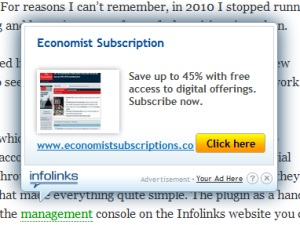 In March I decided that I’d start testing different blog advertising products that were available on the market. I’ve been out of the website advertising game for nearly two years, which is practically a lifetime in internet time.
In March I decided that I’d start testing different blog advertising products that were available on the market. I’ve been out of the website advertising game for nearly two years, which is practically a lifetime in internet time.
My first blog advertising test was going to be with Infolinks In-Text Advertising. Infolinks is an interesting product in that an advertiser can choose the different keywords or key phrases that they want to advertise on, such as “blog advertising”. In that regard it is similar to how Google AdWords and Google Adsense works. What makes it interesting and quite different, is that while Google Adsense provides text links or banner ads to a publishers website in a predefined space allocated by the publisher, Infolinks adds additional hyperlinks to the page based on the phrases that an advertiser wants to be associated to.
 When a user views a website publishing Infolinks ads, they’ll see the standard hyperlinks added by the website owner which are traditionally underlined and blue. Along side the traditional links, they’ll see Infolinks ads or links injected into the page that are a bright green by default (which can be customised) and carry a dotted or double underline to differentiate them from a plain link. When the user hovers over one of the Infolinks links, a small popup will appear near the link they hovered displaying the advertisers chosen ad and provide a way to click through to their website.
When a user views a website publishing Infolinks ads, they’ll see the standard hyperlinks added by the website owner which are traditionally underlined and blue. Along side the traditional links, they’ll see Infolinks ads or links injected into the page that are a bright green by default (which can be customised) and carry a dotted or double underline to differentiate them from a plain link. When the user hovers over one of the Infolinks links, a small popup will appear near the link they hovered displaying the advertisers chosen ad and provide a way to click through to their website.
Signup
Signing up for Infolinks In-Text Advertising was a straight forward process and my account was activated within 24 hours of completing the online form.
I was pleased to see that Infolinks didn’t ask for too much personal information, enough to do their job and not a lot more which I think is great. To often these days businesses think they have a right to all of your personal information and I just don’t think that is reasonable in today’s age.
Installation
Installation of the Infolinks website advertising service was simple, notably because this blog runs WordPress and Infolinks provide a WordPress plugin that does all of the heavy lifting.
I was able to use the Install Plugins page within WordPress, search for “infolinks” and found their plugin without any issue. If I could offer a simple suggestion, it would be to change their plugin name from “Infolinks Official Plugin” to “Infolinks In-Text Advertising Official Plugin”, just to provide a little bit of extra relevance for users scanning down the bold plugin names within WordPress.
Configuration
The configuration provided by the WordPress Infolinks plugin is quite simple. As a publisher you can turn it on or off, provide your Publisher ID and Website ID so your Infolinks ads are tracked properly along with a handful of other basic options.
Most of the configuration for Infolinks, in terms of how it appears visually within a website and how it behaves is actually handled within the Infolinks website. For example a publisher can change the colour of the links, whether to use a dotted or double underlined links, vary the maximum number of links per page and specify a website content category to improve the relevance of the advertisers ads.
While the actual installation of the Infolinks WordPress plugin was straight forward, I thought Infolinks completely dropped the ball with the most important part of the whole process and that is getting the Infolinks configuration and script into the publishers website.
Instead of making that process completely seamless, a publisher is left to their own devices to take the configuration script provided by the Infolinks website and find a way to add that script to their own website. I ended up hacking it into my site using a completely unrelated WordPress plugin and I had to stuff around to get it to work. I could have edited my WordPress theme, however that seemed overkill for something that should have been simple.
I think Infolinks are missing a huge opportunity within the WordPress community by not making this part of the process simpler. Instead of leaving publishers to their own devices to find a way to get the script into their website – they should have provided a simple textbox within the Infolinks WordPress plugin to paste the configuration script provided by the Infolinks website and then dynamically add that to the <head> section of the site using the WordPress theme API.
Reporting
Infolinks reporting interface provided the following information:
- Net Impressions (Impressions that actually displayed Infolinks ads)
- Clicks
- CTR (Clicks/Net Impressions * 100)
- eCPM ((Earnings / Net Impressions) * 1000)
- Earnings
Out of the box they also provide five different date ranges, such as this month, last three months, since last payment along with custom date ranges, daily detail and summary views.
The above is certainly enough to get a feel for how well or poorly a website performing from an advertising stand point but I felt it was missing information about what pages on a website are generating clicks. As an example, over the last eight years I’ve been blogging I have published over 600 different posts, however I have no idea if it is three posts generating all the clicks, a particular category of posts or if it is evenly distributed. Knowing this information might influence my future writing, if there was money to be made in a particular vertical.
Earnings
Now the all important information, how much did I earn between 7/3/2012 and 9/4/2012 of having the Infolinks In-Text Advertising service running on my blog – the answer is not a whole lot.

What the above summary information says is that I served 9391 pages with Infolinks ads present, received 142 clicks, averaged 1.58% Click Through Rate with an eCPM of $0.34 and earned a total of US$2.81.
That’d mean if I continue to display Infolinks ads throughout my site for the next 12 months, I could nearly afford to buy two Gold Class movie tickets. Hardly worth the distraction to the user experience, so I’ll be moving onto the next advertising product to see if it performs any better.
 Last night Claire and I attended the opening night of Jabbawockeez at Jupiters Hotel & Casino in Broadbeach.
Last night Claire and I attended the opening night of Jabbawockeez at Jupiters Hotel & Casino in Broadbeach.

